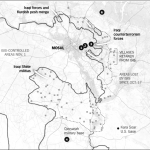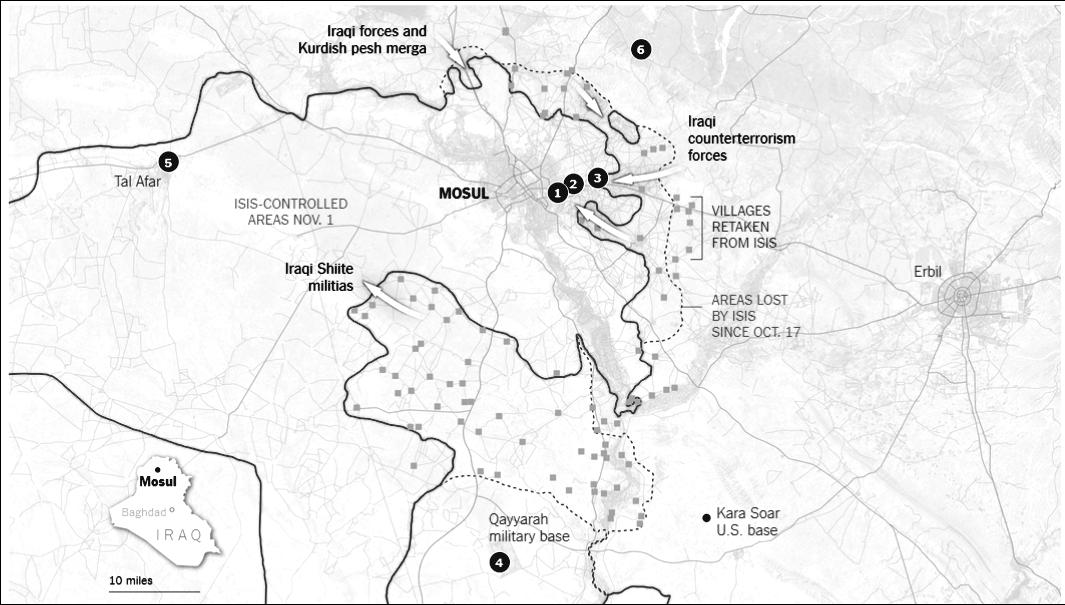The last time the US withdrew from Iraq, it abandoned its allies and left a vacuum for ISIS to grow. This time, the US should learn from past lessons and work for a better peace.
I
n 2014, the world watched in shock as the violent footage began to surface—brutal beheadings and mass killings. A young and barbaric rogue state lay behind the massacres: the Islamic State of Iraq and Syria (ISIS). Almost overnight, the self-proclaimed Caliphate became a household name with the singular ability to unify the world against it. Sixty-six nations joined a coalition to counter ISIS.1 After over 15,000 airstrikes and countless skirmishes,2 ISIS has begun to crumble. In June, the Iraqi government retook the ISIS stronghold of Fallujah.3 In an even more humiliating blow, Dabiq fell on October 16.4 ISIS claimed that their defense of this town would usher in the apocalypse; instead, it fell to Turkey-backed rebels after only a few hours of light fighting.4 Now Iraq moves against ISIS’s last stronghold in Iraq: Mosul.5 ISIS may be about to collapse, but the troubles in the region of Iraq and Syria are far from over.
Eight years ago, the United States assumed that it had solved its problems in Iraq. As a result, ISIS was given the chance to grow with few impediments. The US must not make the same assumption that the worst is past. Its current strategy in Iraq and Syria may be laying the seeds for the next iteration of ISIS. According to the Congressional Research Service, there are three elements of Coalition military strategy in Syria: first, air strikes; second, special operations; and third, training and equipping local security forces.1 The last of these tactics raises the most concerns. It was the misuse of this tactic which left Iraq ripe for ISIS after the Iraq War. During the Iraq war, the US trained and equipped local Sunni forces, but in 2008 and 2009, the Iraqi government failed to integrate the Sunni forces the US had supported. The result was resentment—conditions ripe for ISIS. Similarly, without careful handling, US trained sectarian groups in Iraq and Syria will perpetuate conflict even after ISIS has been destroyed. The US must plan not only for the present destruction of ISIS, but also for long-term peace among sectarian groups in the aftermath of this war.
A particular area of concern is the birthplace of ISIS: western Iraq. In order to create abiding peace, the US must first understand this region and the bitterness that filled it when US forces left. The history of this region demonstrates the importance of continued post-war US efforts in Iraq and sheds light on the needs of a people who have twice turned to terrorism and violence in a mere 13 years.
Sectarian History of Iraq
After the fall of the Ottoman Empire and before the toppling of Saddam Hussein, Sunnis enjoyed special status and advantage in Iraq.6 Preferential treatment of Sunnis in Iraq originated following World War I. During the Great War, the United Kingdom promised power to the Hashimites, the Sunni rulers of the Hejaz, in exchange for their support against the Ottoman Empire. The UK kept its promise, awarding the Hashimites rule over Iraq and Jordan.7
After WWI, Iraq would face the consequences of the Hashimites’ reward. Ignoring tribal and sectarian boundaries, the UK took three Ottoman Provinces and forced them together. This was the origin of Iraq: an artificial construct meant as payment for services rendered. This new nation cut through the region of Kurdistan, forcing Kurds and Arabs into the same state. This boundary, drawn at the stroke of a pen, led to conflict after conflict throughout the 20th century.8 Moreover, the Hashimite rulers were Sunni, while Iraq is majority Shia. The difference in numbers is significant: Shia form 60%-65% of the population, while the Sunni form no more than 37%.9 The two groups are not integrated, but tend to be separated territorially. The Sunni enjoy a majority presence in three provinces in west Iraq, while the remainder of Iraq is majority Shia.10 Even when the relatively secular Ba’ath party came to power, it continued to give advantages to the Sunnis over the Shia. Saddam Hussein himself, the leader of Ba’ath Iraq, was Sunni.7 Hussein, in an effort to avoid conflict with the Sunni tribes, gave them “lavish” economic patronage and used them for military support.11 Hussein’s Sunni inclinations motivated American support for Iraq in the Iran-Iraq war: Shia Iran could export its state-religion ideology most easily to Iraq, another Shia majority country. Because Hussein supported the Sunnis rather than the Shia, he formed an effective block to the expansion of Khomeini’s revolution. Thus, in order to advance American interests against Shia Iran, the US supported the Sunni Iraq government, encouraging the minority to wield power over the majority.
Eventually Saddam Hussein went too far when he invaded Kuwait. Still, he managed to hold the reins of power despite his crippling loss in Operation Desert Storm, devastating sanctions, and separatist movements.7 In the aftermath of 9/11 and the U.S. invasion of Afghanistan, American leaders claimed that Iraq possessed WMDs. America efficiently defeated the Iraqi army and government in 2003, winning the conventional war in months.12 For the first time since World War I, Sunnis no longer held power in Iraq, but after a century of preferential treatment, they did not take this change lightly.
The Insurgency
Conventional victory in Iraq set up the insurgency which followed because the US excluded former members of the Ba’ath party from the new government. These individuals saw insurgency as their only way to return to power and began to struggle against American forces.13 The Ba’athists, being Sunni themselves, worked with the Sunni tribes of West Iraq which were still stung by the sudden loss of their privileged status. These Sunni tribes were particularly eager to join the insurgency as they felt their lack of power and feared the Iraqi government, which naturally placed power into the hands of the Shia majority.6
The Ba’athists did not run the only insurgency—Shia forces, in particular the Mahdi Army, also struggled against Coalition forces and the government which had been established in Iraq, for separate reasons.14 However, the Ba’athist insurgency in West Iraq was particularly effective because the Ba’athists were able to supply military and governing experience, and the Sunni tribes were able to supply a population willing to fight.14 The insurgency was at its most powerful in the province of Anbar, which has a large population of Sunni tribes.
Al-Qaeda in Iraq (AQI)—a Sunni terrorist group—saw an opportunity in this chaos. In this fragmented region they saw the chance to establish a theocratic government harking back to the early days of Islam—a caliphate. They moved into western Iraq and began to work alongside the tribal Sunni insurgents. AQI stirred up steadily greater sectarian violence, aiming to destroy the Coalition forces. Finally, seeing an opportunity to create greater chaos and division, AQI appears to have bombed one of the holiest Shia mosques—al-Askari. Immediately, violence wracked the nation as Shia screamed for revenge. The resulting cycle of revenge drove the country toward a sectarian civil war between 2006 and 2007.6
The situation in Iraq was so bad that in 2007 Professor Michael Waller, a Senior Analyst in Wikistrat’s Analytic Community with a PhD in International Security affairs, claimed, “As of this writing, odds are even that the insurgents and terrorists could win in Iraq.”15 However, despite AQI’s apparent victory, it had already undermined its own cause in numerous ways.
The Awakening
AQI failed to accept that the tribal Sunni insurgents did not fully share their views on religion. The Sunnis who were supposed to be part of AQI’s future caliphate only worked with the terrorist group because “the enemy of my enemy is my friend.” The Sunni tribes opposed the Coalition and the Shia, just like AQI. Yet AQI decided to impose multiple burdens upon the Iraqi tribes with which it was allied.
First, it tried to establish deep roots by forcibly marrying local girls to AQI fighters, violating tribal customs against marrying outside the tribe.16
Second, they tried to impose their strict religious laws on the areas they entered, refusing to compromise with local tribes.6
Third, their proposed form of Islam—Salafism—is a purist strain of Sunnism. The tribes, however, accepted a form of Sunnism which was blended with Sufism—mysticism. AQI’s purism caused it to oppose the tribes Sufi mysticism. In particular, AQI opposed shrines, a popular element of Sufism common to local tribes.
Fourth, AQI cut into tribal pocketbooks as it began to take over smuggling to support itself. This smuggling was typically the domain of tribes, and the tribes did not appreciate the competition.17
Fifth, AQI asserted its authority over the tribal leaders.6
Sixth, AQI’s violence truly revolted many Sunnis. One story captures the emotions members of the Sunni tribes felt when they saw AQI’s violence:
Fallujah … I remember the day [March 2007] that I got there. I think it was the secretary of the city council, his nephew … a 12-year old boy [who] was hit by AQI right on the main street in Fallujah. Ran him over with a vehicle several times. Broke several, maybe all his bones. Then threw him on the door step of the secretary of the council’s house and shot him in front of everybody. … We couldn’t get there. Everybody got there too late. The populace knew who did it. They knew why they did it. … They had had it. That was it. They stopped. They stopped listening to AQI. They turned.18
AQI’s violence was so excessive that they were even reprimanded by Al-Qaeda in a letter from Zawahiri.19
The final straw for the Sunni tribes came in 2006 when AQI tried to establish the Islamic State in Iraq (ISI), asserting their authority over the region.6 The Sunni tribal leaders looked with new eyes at their war with the coalition and for the first time realized that they could not win in the long run. According to Austin Long, an Associate Political Scientist at the RAND corporation, “Attitudes began to shift in early 2005, following the massive coalition assault on Fallujah in November 2004 and the Iraqi national elections in January 2005. Many tribal leaders began to conclude that the political process might hold more benefit than continued fighting.”11 In essence, the tribes became discouraged with the war and began to fear that that the coalition and the Shia majority would exclude them from power if they remained insurgent.
With AQI’s declaration of an Islamic State in Iraq, the Sunnis also realized that AQI posed a greater threat than the Coalition, because AQI would remain long-term while the Coalition planned to leave as soon as it could.18 The effort Coalition special forces had done to plant seeds of doubt throughout Sunni tribes would eventually bear fruit in the Awakening.21 Finally, tribes throughout Anbar—the heavily Sunni province in west Iraq which had experienced and supported much of AQI’s activity—forged an alliance with one another against AQI in 2006.
This alliance was called the Anbar Awakening.17 The tribes of the Awakening united with Coalition forces against terrorism. These forces would go by many names including the Sahwa and the Sons of Iraq (SOI). AQI realized its mistake too late, lamenting, “We helped them to unite against us.”6
Now Sunnis, who had recently been fighting against America, began to fight against AQI. The Coalition provided economic incentives to join the fight against AQI. American funds also denied allies to AQI by providing an alternative form of employment. In the words of one sheikh:
Let’s be honest. They established the Sahwa in our city after all the doors had been shut in our face because there was no chance to hold jobs. The first reason for establishing the Sahwa was because there were no jobs; the second reason—to provide money for the families; and the third reason—to protect the civilian people. When we joined the Sahwa, we had to remind each other why most of us were insurgents … Either get us a job or Iraq will go back to the way it used to be.18
The US acted pragmatically on every motive it could find to separate the Sunnis from the terrorists with whom they had been allied. In the above case, it acted on the tribes’ economic interests. This effectively built up the Awakening and undermined AQI. The work of the Coalition was successful. By 2008, 90,000 Sunnis had joined Sons of Iraq.20 The motives of SOI were not necessarily pure opposition to terrorism—many were in it for the money. Regardless, as they allied with the coalition, successful aid became a status symbol—“letters of appreciation, on tattered pieces of paper and blurry from being copies of copies with the previous recipients names blanked out, were more valuable than money. A signed letter by the coalition, regardless of whether the words were level on the page, was a sought after status symbol.”18 The Coalition had begun to form bonds with the members of SOI.
The Coalition expanded SOI, both using and allowing itself to be used by the Sunni tribes. Sometimes one tribe would call American forces to help it fight against a rival tribe which had allied with AQI.18 At other times, the United States reminded the Sunnis that they were in the minority, and would need to prove their place in the new nation.18 Sometimes the violence and presumption of AQI pushed tribes into the SOI.6 The motivations of the tribes were diverse, but the results were dramatic and relatively cheap. This movement cost the Coalition only $400 million dollars by 2009,18 when foreign involvement in the program ended.20 According to General Petraeus, the movement was worth the money: “These volunteers have contributed significantly in various areas, and the savings in vehicles not lost because of reduced violence, not to mention the priceless lives saved, have far outweighed the cost of their monthly contracts.”18 The Anbar Awakening was the turning point in the war against the remaining insurgents. Much of the success of the Surge can be attributed to the Anbar Awakening.21 The assistance of locals in the war with AQI was invaluable in bringing that terrorist group to its knees. Unfortunately, it was not to last.
Rise of the Caliphate
Before the US left Iraq, it had promised to ensure that members of SOI would be given jobs in the new Iraqi government and armed forces. This would make sure that the Sunnis—who composed a majority of the SOI—would have a place in the new nation. Instead of honoring its promise, the US decided to follow a politically expedient course in 2009, quickly withdrawing its troops and abandoning its allies. The Shia Iraqi government did not trust the Sunni SOI.21 Before leaving Iraq, the US tried to force the Shia government to reconcile with the Sunnis. The Iraqi government made promises, but it did not keep them. Instead, as soon as America had withdrawn its troops, the government stopped paying the SOI it had hired, stopped hiring members of the SOI, carried out acts of violence on Sunnis, and arrested and framed leaders of the Anbar Awakening.17 SOI members were not allowed to carry weapons they needed for self-defense.17 As the Sunnis began to feel oppressed, a door opened for AQI. America had made a promise to integrate the SOI, to find them a place in the Iraq government, not to leave them powerless.
When America pulled its troops out of Iraq, it lost the ability to make the Iraqi government keep its promises to integrate members of SOI. The results of this failed integration were obvious—and not merely in retrospect. In 2009, Mark Wilbanks and Efraim Karsh warned that AQI still posed a threat and if the SOI were not integrated into the Iraqi Security forces, it would be a fatal mistake.18 It was. As the Sunnis felt oppressed, they began to open up to AQI once again. After all, many of them had turned away from AQI in order to get jobs or power. Instead they had been lied to and oppressed. AQI slaughtered many of the former SOI as it assumed a new name—known in English as ISIS or ISIS.22 Oppressed by its own government, threatened by ISIS, and abandoned by America, some of the former Sons of Iraq have rejoined the radical forces they left all those years ago.17
It is hard to see the Sons of Iraq turning against their Coalition allies if they had remained employed and had not been oppressed. That many were real enemies of AQI seems evident in ISIS’s slaughter and denunciation of former SOI members.18 In the end, Iraqi oppression turned allies into enemies. Colonel Dermer wrote, “The Sahwa from 2007-09 is no more. And, yes, the Sunni are now doing what it takes for their own political interests, so things have come full circle because ISIS is the new al Qaeda—the vanguard.”23 It was not US training which caused former members of the SOI to join ISIS. It was American abandonment.
Present Application
This brief glance at the historical development of sectarian conflict between Sunnis and Shia in Iraq reveals three practical applications. First, simply destroying ISIS will not be enough to ensure peace. When the US withdrew from Iraq, they had nearly destroyed AQI. Unfortunately, they neglected to retain sufficient forces in Iraq to pressurize the government to include both Sunnis and Shia. With long established historic grievances, the two sects will not naturally work together. If Iraq is to be anything other than a source of terrorism, it will have to incorporate both Sunnis and Shia in its government. This cannot be achieved if the US remains passive.
Second, the Anbar Awakening shows an effective model for US foreign policy in countering groups like ISIS. The US maintained a pragmatic mindset as it allied with locals by promising aid, money, or power. It drove a wedge between the terrorists and the tribes, emphasizing the horrors wrought by groups such as AQI and pointing to their power-hungry rhetoric. The Awakening demonstrates that tribal alliances with terrorist groups are often uneasy at best, and a negative propaganda campaign, as proposed by Waller in Fighting the War of Ideas like a Real War, may indeed have a strong effect. Even devout local Muslims can be turned to fight against groups like AQI and ISIS. Locals should not be dismissed as necessarily supportive of terror groups.
Finally, the ultimate destruction of the SOI should hold a place in the mind of all US policymakers: abandoning allies has consequences. Right now, the US is training and equipping local forces. They are making promises to these forces. If the US does not follow through with its promises, the results will be disastrous both for the United States and for the trained troops, just as in the aftermath of the War in Iraq. One account reveals the destruction that struck the Sons of Iraq when they were abandoned by America.
A couple of years ago I was in Amman, Jordan, and was invited to meet with one of the Sahwa leaders we had worked closely with in western Baghdad. When I entered the home arranged for our meeting, he had his hands in his pockets and his countenance was not one of seeing a long-lost friend. Staring at me, he pulled his hands out of his pockets and dumped two handfuls of military-unit coins—decorated with logos of various U.S. units—on the table. The coins represented mementos of appreciation from various American commanders the Sahwa leader had worked with. Now they crashed onto the table and several fell to the floor. He said: “What good are these now?”23
This abandonment not only harmed the fighters, it set up the current conflict with ISIS which plagues the United States to this day and has cost over nine billion dollars.2 The SOI were left between the abuses of the Iraqi government and the violence of ISIS. Some of those who were not executed chose to join ISIS, and many more simply chose not to oppose the terrorists. ISIS would not have been able to storm across western Iraq so quickly if it had not fed off of Sunni resentment. The United States must follow through with its promises to those it intends to train. To do otherwise is to court disaster. ■
- Kathleen McInnis, “Coalition Contribution to Countering the Islamic State,” Congressional Research Service, August 24, 2016, https://www.fas.org/sgp/crs/natsec/R44135.pdf (accessed November 5, 2016).
- “Operation Inherent Resolve,” US Department of Defense, November 2, 2016, http://www.defense.gov/News/Special-Reports/0814_Inherent-Resolve (accessed November 5, 2016).
- Tamer El-Ghobashy andGhassan, Adnan, “Iraqi Forces Take Full Control of Fallujah From Islamic State,” Wall Street Journal, June 26, 2016, http://www.wsj.com/articles/iraqi-city-of-fallujah-fully-liberated-from-islamic-state-iraqicommander-says-1466934423 (accessed November 5, 2016).
- William McCants, “Apocalypse Delayed,” Brookings, October 17, 2016. https://www.brookings.edu/blog/markaz/2016/10/17/apocalypse-delayed/ (accessed November 7, 2016).
- Mosul: Iraq and Turkish Troops Make Gains in Battle,” BBC News, October 17, 2016, http://www.bbc.com/news/world-middle-east-37679325 (accessed November 7 2016).
- Andrew Phillips, “How al Qaeda lost Iraq,” Australian Journal of International Affairs 63, no. 1 (2009): 73. http://dx.doi.org/10.1080/10357710802649840 (accessed May 3, 2016).
- Tamim Ansary, Destiny Disrupted: A History of the World through Islamic Eyes (New York: Public Affairs, 2010).
- Albert Hourani, A History of the Arab Peoples (New York: Warner Books, 1992). “The World Factbook: Iraq,” Central Intelligence Agency, April 27, 2016, https://www.cia.gov/library/publications/the-world-factbook/geos/iz.html (accessed May 3, 2016).
- Yaroslav Trofimov, “After Minority Rule, Iraq’s Sunnis Refuse Minority Role,” Wall Street Journal, April 9, 2015, http://www.wsj.com/articles/iraqs-sunnis-dont-accept-minority-role-1428571127 (accessed May 2, 2016).
- Austin Long, “The Anbar Awakening,” Survival Vol. 50, no. 2 (April 2008): 73-74, http://faculty.maxwell.syr.edu/rdenever/USNatSecandForeignPol/Long,%20Anbar%20Awakening.pdf (May 3, 2016).
- Max Boot, “The New American Way of War,” New York Times, July 25, 2003, http://www.nytimes.com/cfr/international/20030724faessayv82n4_boot.html?pagewanted=print&position (Accessed May 2, 2016).
- James P. Pfiffner, “US Blunders in Iraq: De-Baathification and Disbanding the Army,” Intelligence and National Security Vol. 25, No. 1 (February 2010), http://pfiffner.gmu.edu/files/pdfs/Articles/CPA%20Orders,%20Iraq%20PDF.pdf (accessed May 2, 2016).
- Stephen Biddle, Michael E. O’Hanlon, and Kenneth M. Pollack, “The Evolution of Iraq Strategy,” Brookings Institute Press, December, 2008. http://www.brookings.edu/~/media/research/files/papers/2008/12/iraq-biddle/12_iraq_biddle.pdf (accessed May 2, 2016).
- Michael J. Waller, Fighting the War of Ideas like a Real War (Washington: The Institute of World Politics Press, 2007).
- Greg Bruno, “Finding a Place for the ‘Sons of Iraq,’” Council on Foreign Relations, January 9, 2009, http://www.cfr.org/iraq/finding-place-sons-iraq/p16088#p1 (accessed May 3, 2016).
- Myriam Benraad, “Iraq’s Tribal ‘Sahwa’: Its Rise and Fall,” Middle East Policy Council Vol. 18, no. 1 (Spring 2011), http://www.mepc.org/journal/middle-east-policy-archives/iraqs-tribal-sahwa-its-rise-and-fall (accessed May 2, 2016).
- Mark Wilbanks and Efraim Karsh, “How the “Sons of Iraq” Stabilized Iraq,” Middle East Quarterly (Fall 2010), http://www.meforum.org/meq/pdfs/2788.pdf (accessed May 2, 2016).
- “Zawahiri’s Letter To Zarqawi (English Translation),” Combatting Terrorism Center. https://www.ctc.usma.edu/v2/wp-content/uploads/2013/10/Zawahiris-Letter-to-Zarqawi-Translation.pdf (accessed May 3, 2016).
- “Measuring Stability and Security in Iraq,” Report to Congress (March 2009), http://www.defense.gov/Portals/1/Documents/pubs/Measuring_Stability_and_Security_in_Iraq_March_2009.pdf (accessed May 3, 2016).
- Dale Andrade, Surging South of Baghdad: The Third Infantry Division and Task Force Marne in Iraq 2007-2008, Dale Andrade (Washington: Center of Military History, 2010).
- Abigail Hauslohner, “In Baghdad, middle-class Sunnis say they prefer militants to Maliki,” Washington Post, July 12, 2014, https://www.washingtonpost.com/world/middle_east/in-baghdad-middle-class-sunnis-say-they-prefer-militants-to-maliki/2014/07/11/fa0b66a7-1b09-409a-a5ed-ab580bc93a4a_story.html (accessed May 3, 2016).
- Philip Dermer, “The ‘Sons of Iraq,’ Abandoned by their American Allies,” Wall Street Journal, July 1, 2014, http://www.wsj.com/articles/philip-dermer-the-sons-of-iraq-abandoned-by-their-american-allies-1404253303 (accessed May 3, 2016).
Image Credit: A US soldier chats with a Sons of Iraq member at a checkpoint, 2004 | © US Army | Flickr/Creative Commons




